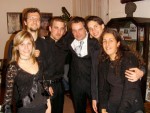Title
Eyes misled ears on the evening of October 21 in Budapest. Eyes saw musicians framed beneath the spreading chandelier of the Liszt Academy, continuing a tradition of concert life that has changed little since the academy was founded in 1875. Ears, however, heard piece after piece of music being performed for the first time, more than 125 years after Franz Liszt taught in the same hall. Despite the competition of another contemporary music concert, the hall was filled that night, the last evening of the month-long Budapest Autumn Festival.
Body
That concert—and its twin in New York City eight days later—were the culmination of the Danube-Hudson Project, which commissioned new works from three Juilliard composers and three composers from the Franz Liszt Academy. For the performances, organized by Joel Sachs at Juilliard and Balazs Horvath at the Liszt Academy, the composers traveled overseas to rehearse the music with musicians at each other’s schools. Both concerts were conducted by the enterprising Mr. Sachs, who led the rehearsals in Hungarian, after studying the language in the weeks prior to the exchange.
The precedent for the exchange was set by a similar endeavor several years ago, arranged by Mr. Horvath and Kati Agocs, then a D.M.A. student at Juilliard. Last year’s Focus! festival, featuring Hungarian music since Bartok, provided the context for Mr. Sachs and Mr. Horvath to renew the exchange.
In the standard classical repertoire, a performance tradition hundreds of years old supplements the notes on the page. Not so for composers writing in contemporary styles that, as of yet, have no extensive tradition behind the notes. As the composers of the Danube-Hudson Project discovered, ensembles seeing the same new piece for the first time may diverge greatly in their approach to the music—especially since one ensemble’s strengths, sound, and style are likely to differ from another’s. What made this project uniquely valuable to the composers was the opportunity to hear each piece played by different instrumentalists in quick succession, allowing them to tackle problems of notation and balance with the assistance of accomplished players at both the Liszt Academy and Juilliard.
In general, the Liszt Academy’s players seemed to favor a blended sound, which made the more textural pieces on the program silky smooth (aided by the resonance of the hall at the old academy). At Juilliard, individual lines stood out in greater relief, emphasizing the moments when musical conversations occurred between the players. Discussions between the American composers and Hungarian performers drifted between spoken communication and hummed examples. Despite the language barrier, the socializing among the students from the two conservatories proved to be a real highlight of the exchange.
Each piece was a response to Pierre Boulez’s Dérive I (written in 1984), using the same six instruments as Boulez did: flute, clarinet, vibraphone, piano, violin, and cello. Dérive, which has become a contemporary staple, is based upon music Boulez omitted from his own Répons, itself a response to his Poésies pour pouvoir. In the Danube-Hudson Project, six composers were able to continue this chain of derivations by writing music inspired by Dérive, each in his own way.
For all the diversity of its instruments, this ensemble was to 20th-century composers what the more homogenous string quartet was to Mozart, Haydn, and Beethoven. Ever since Schoenberg’s Pierrot Lunaire for the same basic instrumentation (minus vibraphone), this set of sonic possibilities has served as a benchmark for composers. In the case of the Danube-Hudson Project, the identical instrumentation from piece to piece also served as a kind of experimental control, keeping the composers’ timbral resources the same, and thus distilling other musical ideas for comparison.
The new pieces had more in common with each other than they did with the Boulez, which began both halves of each concert program. Dérive itself is a bubbling collection of trills and tremolos, sometimes boiling, sometimes simmering. The new piece most similar to the Boulez was Mate Bella’s Equivalence, which explicitly used the Boulez work as a template to be distorted. The result was an aggressive, nightmarish version of Dérive, in which gestures could be linked directly to their counterparts in Dérive, but where the harmony and atmosphere were all askew.
Peter Zombola’s obsessive Sextet fixated upon harmonies that it reiterated, sometimes brashly, sometimes in a more subdued fashion. Particularly effective was a moment in which it seemed that the strings and winds would lead the ensemble into different harmonic territory, only to have everyone come crashing down once again onto the obsessed-over notes.
This insistent attitude seemed to permeate much of the other music as well, whether through recurring rhythms, fixed harmonies, or constant textural devices. Kyle Blaha’s Effects opened with repeated, steely chords on the piano that would return to punctuate the piece’s delicate texture.
Jakub Ciupinski’s Sonar established a pointillistic environment that morphed underneath a floating melody in the violin. The piece unexpectedly tapered off at the end, like a slow-motion tribute to the Boulez, which ends in a collective stutter.
Balint Horvath’s Pages From my Diary wordlessly set four texts. Its insistent elements were a few musical intervals, which persisted in various ways no matter what the style of each movement. My own piece, Cellular Automata, restlessly switched from character to character, but the frequent recurrence of a few motives lent it a certain obsessiveness as well.
For many of the performers, these six new pieces were their first forays into the unfamiliar landscapes of contemporary composition, and it was the first time these Juilliard composers had visited Hungary. After the initial shock of immersion in a new language, musical or otherwise, all came to the same conclusion: that this experience would be the first of many.





